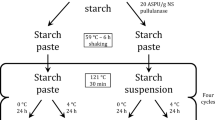Abstract
The aim of the study was to investigate particle and powder properties of various starch acetate powders, to study the effect of these properties on direct compression characteristics, and to evaluate the modification opportunity of physical properties for starch acetate powders by using various drying methods. At the end of the production phase of starch acetate, the slurry of starch acetate was dried using various techniques. Particle, powder, and tableting properties of end products were investigated. Particle size, circularity, surface texture, water content and specific surface area varied according to the particular drying method of choice. However, all powders were freely flowing. Bulk and tapped densities of powders varied in the range of 0.29 to 0.44 g/cm3 and 0.39 to 0.56 g/cm3, respectively. Compaction characteristics revealed that all powders were easily deformed under compression, having yield pressure values of less than 66 MPa according to Heckel analysis. All powders possessed a significant interparticulate bond-forming capacity during compaction. The tensile strength values of tablets varied between 10 and 18 MPa. In conclusion, physical properties of starch acetate could be affected by various drying techniques. A large specific surface area and water content above 4% were favorable properties by direct compression, especially for small, irregular, and rough particles.
Similar content being viewed by others
References
Korhonen O, Raatikainen P, Harjunen P, Nakari J, Suihko E, Peltonen S, Vidgren M, Paronen P. Starch acetates-multifunctional direct compression excipients. Pharm Res. 2000;17:1138–1143.
Raatikainen P, Korhonen O, Paronen P. Particle properties and deformation characteristics of starch acetates. Drug Dev Ind Pharm. 2001;28:165–175.
Paronen P, Peltonen S, Urtti A, Nakari J. Starch acetate composition with modifiable properties, method for preparation and usage thereof. US patent 5 667 803. 10/16/1997.
York P. Solid-state properties of powders in the formulation and processing of solid dosage forms. Int J Pharm. 1983;14:1–28.
York P. Crystal engineering and particle design for the powder compaction process. Drug Dev Ind Pharm. 1992;18(6&7):677–721.
Moore JG. Horizontal vacuum rotary dryers. In: Mujumdar AS, ed. Handbook of Industrial Drying. New York, NY: Marcel Dekker Inc: 1987:155–164.
Hovmand S. Fluidized bed drying. In: Mujumdar AS, ed. Handbook of Industrial Drying. New York, NY: Marcel Dekker Inc; 1987:165–211.
Ludde KH, Kawakita K. Die pulverkompression. Pharmazie. 1966;21:393–403.
Heckel RW. Density pressure relationship in powder compaction. Trans Metall Soc AIME. 1961;221 (suppl a):671–675.
Heckel RW. An analysis of powder compaction phenomena. Trans Metall Soc AIME. 1961;221 (suppl b):1001–1008.
Fell JT, Newton JM. Determination of tablet strength by the diametral-compression test. J Pharm Sci. 1970;59:688–691.
Führer C. Interparticulate attraction mechanisms. In: Aldernborn G, Nyström C, eds. Pharmaceutical Powder Compaction Technology. New York, NY: Marcel Dekker Inc; 1996;71:1–15.
Neuman BS, Bean HS, Becket AH, Carless JE. Advances in Pharmaceutical Sciences. 2nd ed. London, England: Academic Press; 1976.
Yamashiro M, Yuasa Y, Kawakita K. An experimental study on the relationship between compressibility, fluidity and cohesion of powder solids at small tapping numbers. Powder Tech. 1983;34:225–231.
York P. Particle slippage and rearrangement during compression of pharmaceutical powders. J Pharm Pharmacol. 1978;30:6–10.
Munoz-Ruiz A, Paronen P. Time-dependent densification behaviour of cyclodextrins. J Pharm Pharmacol. 1996;48:790–797.
Doelker E. Recent advances in tableting science. Boll Chim Farm. 1988;127:37–49.
Nyström G, Aldernborn G, Duberg M, Karehill PG. Bonding surface area and bonding mechanisms—two important factors for the understanding of powder compactability. Drug Dev Ind Pharm. 1993;19:2143–2196.
Ahlneck C, Aldernborn G. Moisture adsorption and tabletting. I. Effect on volume reduction properties and tablet strength for some crystalline materials. Int J Pharm. 1989;54:131–141.
Karehill PG, Glazer M, Nyström C. Studies on direct compression of tablets. XXIII. The importance of surface roughness for compactability of some directly compressible materials with different bonding and volume reduction properties. Int J Pharm. 1990;64:35–43.
Wong LW, Pilpel N. The effect of particle shape on the mechanical properties of powders. Int J Pharm. 1990;59:145–154.
Malamataris S, Karidas T. Effect of particle size and sorbed moisture on the tensile strength of some tableted hydroxypropyl methylscellulose (HPMC) polymers. Int J Pharm. 1994;104:115–123.
Nokhodchi A, Rubinstein MH, Ford JL. The effect of particle size and viscosity grade on compaction properties of hydroxymethylcellulose 2208. Int J Pharm. 1995;126:189–197.
Author information
Authors and Affiliations
Corresponding author
Rights and permissions
About this article
Cite this article
Korhonen, O., Pohja, S., Peltonen, S. et al. Effects of physical properties for starch acetate powders on tableting. AAPS PharmSciTech 3, 34 (2002). https://doi.org/10.1208/pt030434
Received:
Accepted:
DOI: https://doi.org/10.1208/pt030434




